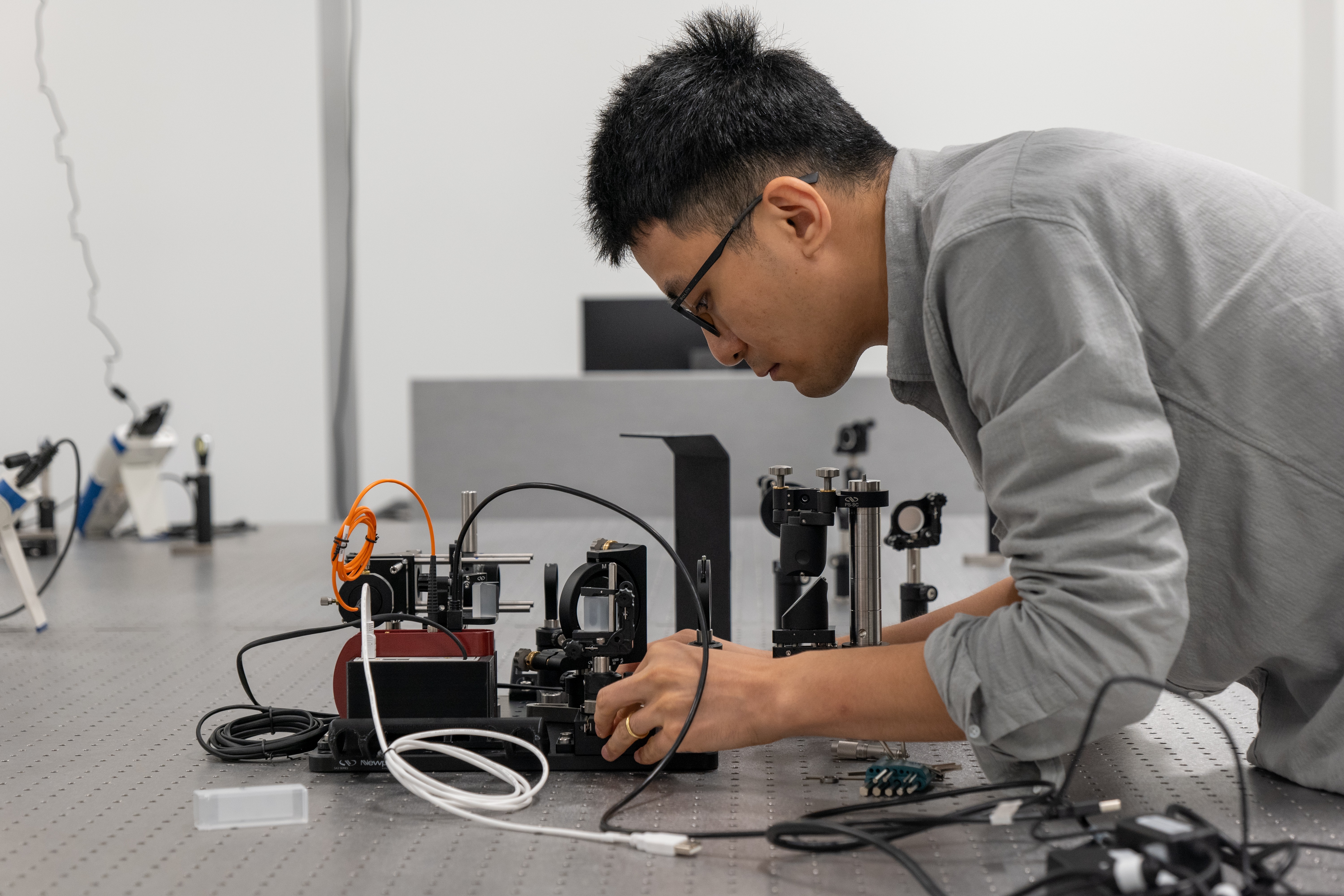COSAM News Articles 2022 January New $500,000+ NSF award enhances emerging quantum research cluster at Auburn University
New $500,000+ NSF award enhances emerging quantum research cluster at Auburn University
Impactful Instrumentation: Wencan Jin uses his ultrafast laser lab in the Department of Physics to conduct 2D magnetic materials research with a $523,200 National Science Foundation (NSF) award.
Wencan Jin sets up the autocorrelator that can retrieve the short pulse durations for example, 50 femtosecond.
For Wencan Jin, the Auburn Family makes a difference with support and guidance, helping him make an impact in the College of Sciences and Mathematics (COSAM).
Jin, who earned his doctorate degree from Columbia University and was a postdoctoral researcher at the University of Michigan, is an assistant professor in the Department of Physics.
In his early career, he conducted research using national lab facilities in the United States, Italy and China.
“Auburn offers faculty a very competitive start-up package competitive to many top universities in the entire United States,” said Jin.
The Auburn Family has supported him from starting up his ultrafast laser lab to submitting a proposal to the National Science Foundation (NSF) Electronic and Photonic Materials (EPM) program.

Jin lab located at the Leach Science Center has a rotational anisotropy second harmonic generation (RA-SHG) system. The system is based on a femtosecond laser, enclosed in the black box. Second harmonic generation is a laser-optical process in which the frequency of incident light is doubled through its second-order nonlinear interactions with the materials. RA-SHG is a powerful tool to detect symmetry breaking of a crystal with high sensitivity by directly probing the nonlinear susceptibility tensor elements.
“The Department of Physics and COSAM have welcomed me and given me an outstanding experience,” he said. “I have had great discussions with Marcelo Kuroda and Ryan Comes in the department about research ideas and received excellent feedback for my proposal from both of them.”
Win’s very first proposal resulted in a successful award.
“We’re so happy that Wencan joined us at Auburn and has been able to build such an impressive lab," said Ryan Comes, the Thomas and Jean Walter Assistant Professor in the Department of Physics. "My group has already collaborated with him on a couple of projects and we’re looking forward to working together for many years.”
Jin is the principal investigator on “Probing novel phases of matter in van der Waals magnet Fe5-xGeTe2” funded by the NSF for $523,200 with co-investigator Peng Li from the Samuel Ginn College of Engineering.

In the black box, there is a Spectra-Physics laser and two noncollinear optical parametric amplifiers (NOPAs). They can generate femtosecond laser pulses at 200 kHz repetition rate in the visible and near infrared range.
“There are incredible possibilities in research in this rapidly expanding field,” Jin added.
Materials in a 2-dimensional (2D) form can exhibit completely different properties in comparison with their 3D counterparts.
“The first demonstration of 2D van der Waals magnetic materials took place just a few years ago in 2017,” Jin said. “This exciting and innovative area of research has unique magnetic properties and offers incredible possibilities.”
The research aligns with the emerging quantum research cluster at Auburn University.
“I am working with the Samuel Ginn College of Engineering to fabricate nano devices,” Jin said.
These devices are characterized using a Physical Property Management System or PPMS at low temperature and high magnetic field.
“It is truly a privilege to have access to these state-of-the-art instruments on the Auburn University,” Jin mentioned.
The collaboration goes beyond the Plains.
“Part of the research are carried out at the U.S. Department of Energy’s Brookhaven National Laboratory in Upton, New York,” Jin said. “I am looking forward to working with them on-site when the lab re-opens to users.”
“The research may find exotic magnetic structures that can be manipulated by electrical currents. It opens the possibilities for potential data storage devices and adds to the array of excellent research in COSAM,” Jin added.
The excellent research in COSAM builds upon the support found in the Auburn Family.
“The Office of the Associate Dean of Research and Graduate Studies provided me with valuable tools for my proposal and during the review, the office was able to make revisions with very short notice,” Jin said.
As he continues his research in COSAM, Jin reflects on being part of this emerging quantum research cluster.

Spencer Johnson, first year graduate student, with Jin. They are running a test on the rotary encoder that Johnson built that can accurately rotate the polarization of the light.
“It is an exciting time to be at Auburn University and I am looking forward to making significant contributions to this global research,” Jin said.
Latest Headlines
-
07/09/2024
-
Summer Bridge Program celebrates 21 incoming Auburn students as they prepare for future STEM careers07/02/2024
-
07/02/2024
-
06/17/2024
-
06/07/2024

